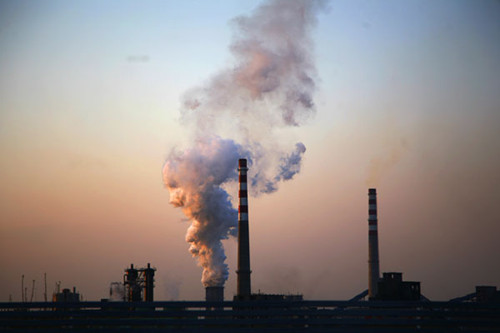

Smoke billows from a factory in Dezhou, Shandong province. To reach mandatory efficiency goals, the government had to take some extreme steps, including power cuts and limits on electricity supply in 2010. Provided to China Daily
As the world's largest energy consumer, China is stepping up its efforts to cut greenhouse gas emissions by rolling out a series of experimental pilot programs
Chinese companies that have long faced relatively low environmental costs will have to figure out efficient ways to cut carbon dioxide emissions as a market mechanism is right around the corner.
The country's first pilot carbon-trading program for cutting greenhouse gas emissions will make its formal debut on Tuesday in Shenzhen, the southern city in Guangdong province that has long been a leader in China's reforms.
The Shenzhen pilot program is expected to hasten the launch of pilots in other regions. The central government has designated four other cities, including Beijing and Shanghai, and two provinces to roll out pilot carbon-trading programs by 2014.
In Shenzhen, about 635 companies accounted for about 38 percent of the city's total emissions, and they will be included in the experimental program.
Using a 2012 baseline of carbon dioxide emissions of roughly 31.73 million tons, Shenzhen will issue 100 million tons of free emissions allowances to companies complying with the program between 2013 and 2015.
Rather than copy cap-and-trade programs in Europe or California, the Shenzhen pilot sets limits on carbon intensity (carbon dioxide emissions per unit of GDP) for emitters.
The 635 companies must achieve an average annual carbon intensity reduction of 6.68 percent by 2015.
However, regions will explore various approaches in establishing their own experimental programs. Cities such as Beijing might adopt absolute emission caps, said industrial experts.
Carbon intensity
"Adopting a carbon intensity index is in line with China's commitment of reducing carbon intensity," said Yang Fuqiang, senior adviser on energy, environment and climate change for the Natural Resources Defense Council in Beijing.
China has set a target of reducing carbon intensity by 40 to 45 percent by 2020, compared with the 2005 levels.
Carbon intensity reduction leaves room for growth by allowing a limited increase of carbon emissions, said Yang.
"All approaches could be used, but the final target is to have a nationwide market, and some kind of top-level programs should be put in place," said Yang.
Most international carbon markets adopt absolute caps, but it still remains uncertain when China will reach an absolute peak in emissions.
Before the two-week climate change talks in Bonn in early June, the peak issue was already in the limelight. Some media reports said China's greenhouse gas emissions might peak before 2025 and the country might introduce a cap in 2016.
Reports about an early cap were dismissed by Su Wei, China's chief climate negotiator in Bonn, while he reaffirmed China's commitment to a carbon-intensity target by 2020.
The peak issue is part of the agenda for China in its sustainable development, but when it will happen requires more in-depth analysis, said Zhou Dadi, vice-chairman of the National Energy Advisory Committee.
Various studies have yielded wide variations for China's carbon emissions peak, ranging from 2025 to 2040.
"The year of 2025, or the period between 2025 and 2030, each has a high probability, but a precondition is China's energy demand for industrialization, which could peak by 2020, and the country could then enter a post-industrial era," said Yang.
Another key factor is the speed of China's urbanization. The quicker the process is, the earlier the country's emissions peak will come, Yang said.
Many Shenzhen businesses are willing to experiment with the new mechanism since it could also generate new business opportunities, though some power plants may be reluctant to adopt the new system, said experts who were involved in the design of the program.
The cost of environmental degradation has been largely ignored during China's impressive economic development in recent decades, putting mounting pressure on the government.
Shanghai to try carbon trading
Thu, Apr 11 2013Carbon emission trading program starts in S China
Wed, Sep 12 2012Carbon trading market research boosted
Tue, Sep 04 2012Shanghai pilots carbon emission trading scheme
Fri, Aug 17 2012Copyright ©1999-2018
Chinanews.com. All rights reserved.
Reproduction in whole or in part without permission is prohibited.